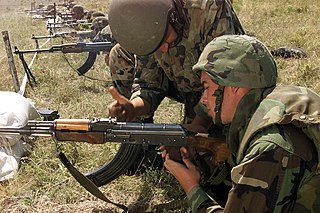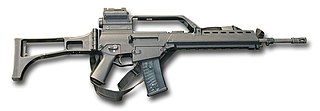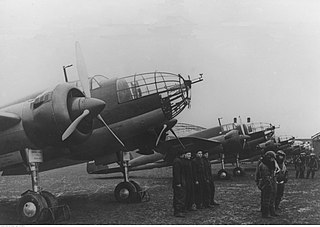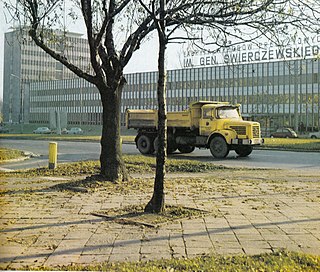
A squad automatic weapon (SAW), also known as a section automatic weapon or light support weapon (LSW), is a man-portable automatic firearm attached to infantry squads or sections as a source of rapid direct firepower. Weapons fulfilling this role can be light machine guns, or modified selective-fire rifles fitted with a heavier barrel, bipod and a belt/drum-fed design.
The Chauchat was the standard light machine gun or "machine rifle" of the French Army during World War I (1914–18). Its official designation was "Fusil Mitrailleur Modele 1915 CSRG". Beginning in June 1916, it was placed into regular service with French infantry, where the troops called it the FM Chauchat, after Colonel Louis Chauchat, the main contributor to its design. The Chauchat in 8mm Lebel was also extensively used in 1917–18 by the American Expeditionary Forces (A.E.F.), where it was officially designated as the "Automatic Rifle, Model 1915 (Chauchat)". A total of 262,000 Chauchats were manufactured between December 1915 and November 1918, including 244,000 chambered for the 8mm Lebel service cartridge, making it the most widely manufactured automatic weapon of World War I. The armies of eight other nations—Belgium, Finland, Greece, Italy, Poland, Romania, Russia, and Serbia—also used the Chauchat machine rifle in fairly large numbers during and after World War I.

The Browning Automatic Rifle (BAR) is a family of American automatic rifles and machine guns used by the United States and numerous other countries during the 20th century. The primary variant of the BAR series was the M1918, chambered for the .30-06 Springfield rifle cartridge and designed by John Browning in 1917 for the American Expeditionary Forces in Europe as a replacement for the French-made Chauchat and M1909 Benét–Mercié machine guns that US forces had previously been issued.

A light machine gun (LMG) is a light-weight machine gun designed to be operated by a single infantryman, with or without an assistant, as an infantry support weapon. LMGs firing cartridges of the same caliber as the other riflemen of the same combat unit are often referred to as squad automatic weapons.

A semi or full-automatic firearm which is said to fire from a closed bolt is one where, when ready to fire, a round is in the chamber and the bolt and working parts are forward. When the trigger is pulled, the firing pin or striker fires the round; the action is cycled by the energy of the shot, sending the bolt to the rear, which extracts and ejects the empty cartridge case; and the bolt goes forward, feeding a fresh round from the magazine into the chamber, ready for the next shot.
The M1917 Browning machine gun is a heavy machine gun used by the United States armed forces in World War I, World War II, the Korean War, and the Vietnam War; it has also been used by other nations. It was a crew-served, belt-fed, water-cooled machine gun that served alongside the much lighter air-cooled Browning M1919. It was used at the battalion level, and often mounted on vehicles. There were two main iterations: the M1917, which was used in World War I and the M1917A1, which was used thereafter. The M1917, which was used on some aircraft as well as in a ground role, had a cyclic rate of 450 rounds per minute. The M1917A1 had a cyclic rate of 450 to 600 rounds per minute.

The Model 35 antitank rifle was a Polish 7.9 mm anti-tank rifle used by the Polish Army during the 1939 invasion of Poland. It was designated model 35 for its design year, 1935: It was also known by its codename "Uruguay", after the country and by the name of its designer, Józef Maroszek(pl).

Ckm wz. 30 is a Polish-made clone of the American Browning M1917 heavy machine gun. Produced with various modifications such as greater caliber, longer barrel and adjustable sighting device, it was an improved although unlicensed copy of its predecessor, and was the standard machine gun of the Polish Army from 1931.

The Model 98a carbine was a Polish derivative of the German Gewehr 98 bolt-action rifle.
The PTRD-41 is an anti-tank rifle that was produced and used from early 1941 by the Soviet Red Army during World War II. It is a single-shot weapon which fires the 14.5×114 mm round, which was able to penetrate German tanks such as the Panzer III and early models of the Panzer IV. Although unable to penetrate the frontal armor of late-war German tanks, it could penetrate their thinner side armor at close ranges as well as thinly armored self-propelled guns and half-tracks.

PZL.46 Sum (sheatfish) was a light bomber of the Polish Air Force before World War II, which, was directed to serial production in the spring of 1939. These planes were in production, but the Polish industry did not manage to produce them before the outbreak of the war.

The karabin maszynowy obserwatora wz.37 is a Polish version of the Browning wz.1928. It was a flexible machine gun used in some Polish airplanes in the beginning of World War II.

The Nkm wz.38 FK was a 20 mm heavy machine gun produced in inter-war Poland. It was used both in anti-air and anti-tank role and was also adapted for tank use and mounted on some TKS tankettes. Mass-produced in 1938 and 1939, it was used extensively during the September Campaign.

Karabin maszynowy wz. 36, also known as Karabin lotniczy uniwersalny wz. 36 was a Polish 7.9 mm calibre aerial machine gun of the 1930s. It was a further modified version of Karabin maszynowy wz. 33, itself a modification of the successful Ckm wz.30 multi-purpose HMG.

Państwowa Fabryka Karabinów was a Polish arms manufacturer active between the two World Wars. Founded in 1919 as the successor to the pre-World War I Gerlach i Pulst company, Fabryka Karabinów became part of the state-owned Państwowe Wytwórnie Uzbrojenia conglomerate in 1927. It was a sister company to Łucznik Arms Factory, the Munitions Factory of Skarżysko, and several others. By the end of the 1930s, Fabryka Karabinów was one of the largest arms producers of Poland. It was destroyed during World War II. Nationalized after the war and with a new focus on civilian precision tools, it was renamed as VIS after 1989, but liquidated in the early 21st century.

The Ciężki karabin maszynowy wz. 25 Hotchkiss was a Polish derivative of the Hotchkiss M1914 machine gun, rechambered for 7.92×57mm Mauser ammunition.
SEPEWE was a Polish arms industry syndicate. Established as a joint venture of the Polish government and 19 private companies of the arms industry, it became one of the largest arms dealerships of the 1920s and 1930s. Between 1926 and 1939 SEPEWE exported Polish and foreign-made military equipment to over 30 states, obtaining between 320 and 350 million zlotys.
















